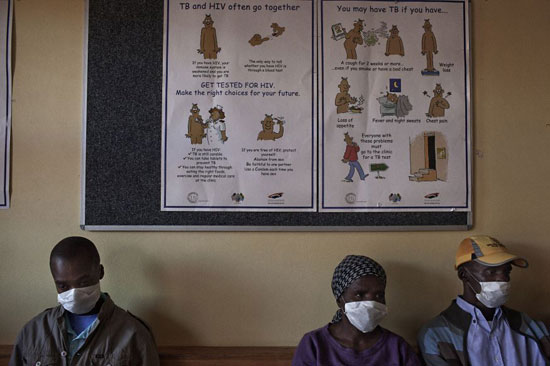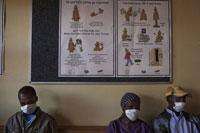Dr. Francis Varaine, an MSF TB expert, discusses the potential impact of this new test, which greatly improves the detection of drug-resistant TB

South Africa © Jose Cendon
People waiting for TB treatment and tests at the Kuyasa Clinic in Khayelitsha township, Cape Town.
A new diagnostic test for tuberculosis that was endorsed by the World Health Organization in late 2010 could well be a game-changer in the international response to a disease that kills nearly two million people each year. Dr. Francis Varaine, a Doctors Without Borders/Médecins Sans Frontières (MSF) expert on TB, discusses the potential impact of this new test, which greatly improves the detection of drug-resistant TB, and how it will affect the need for more reliable and better treatment.
Why is the new test important?
The data that’s been published suggest that this new test, which is based on molecular technology, is a breakthrough, especially because it gives results fast and is easy to use. This is something that deserves to be highlighted, particularly because there have been practically no medical advances in the field of tuberculosis for many years now.
The test is quick, as it provides results in just two hours. It also has good sensitivity—meaning that it reliably gives a positive result if TB bacteria are present. The current “gold standard” test used today is the culture technique. Compared to this method of testing, this new test has a sensitivity rate of 90 percent, which is excellent for a rapid test.
Another advantage is the fact that the test is easy to use. Despite it being a high-tech machine, a laboratory technician can learn to use it with only a couple of hours of training. Once the sputum sample of a patient has been mixed with a re-agent, the sample is left to sit for 15 minutes, then put in the machine. Two hours later, you are given are a positive or negative result. This process requires little manipulation, so there is little risk of contamination and an almost zero margin of error in the interpretation of results. Plus it actually gives not one but two results—first, whether or not there are any Mycobacterium tuberculosis in the sample to establish that the patient does indeed have TB. Second, whether or not the TB bacteria are resistant to rifampicin, one of the main first-line drugs used in TB treatment. These are two key pieces of information to determine a patient’s treatment.
Why is it so important to get a quick diagnosis?
For some patients, a definitive diagnosis with existing tools can take three months. This means that clinicians find themselves having to put a patient on treatment before a complete diagnosis is obtained—so treatment is administered blindly, and it is not always appropriate. If a patient has to wait too long for a definitive diagnosis, it can be fatal. In a highly publicized study, patients in KwaZulu Natal, a province in South Africa, died before receiving their test results. The patients died an average of 16 days after their sputum sample was collected. For all vulnerable TB patients—those in an advanced stage of the disease, those who are co-infected with HIV, or children—delaying the diagnosis and therefore delaying the start of appropriate treatment is a real problem.
And more generally, for all patients, if the waiting time to begin treatment is too long, some will simply not return to the clinic to get treated.
Will MSF use this new test in its projects?
Yes, we have ordered a number of machines that are already in our projects in a wide range of countries including Kenya, Malawi, Cambodia, Colombia, and Abkhazia (Georgia). In the months ahead, we hope to see how this test works in real conditions. What are the effects of environmental factors such as heat, moisture, or dust? How do the requirements of a reliable electrical supply impact on the test, is the installation of air conditioning needed in some laboratories? How do we organize the storage of cartridges and the waste management? A number of logistical and organizational issues still need to be resolved. After that, we can begin assessing the impact of the test’s use in the detection and then treatment of patients.
How does this test fit in to the overall picture of TB diagnosis?
This question is actually very much part of how the test needs to be evaluated, overall. MSF will use the test as the first choice for patients with suspected TB in settings with a high prevalence of HIV co-infection or multidrug-resistant TB. We have developed diagnostic algorithms that will need evaluating. The test must be used in the most rational way possible to quickly detect patients, without going overboard in its use.
Is this the ideal TB test?
The “ideal” TB test would of course be one that could be used everywhere, as close to the patient as possible, in small village clinics in remote areas. This is not the case for this present test. Having said that, it does seem we can use it outside the major reference laboratories, and bring it to the district level and get closer to patients. This will be a huge step forward.
Another limitation of this test is that it has been validated only for sputum for the diagnosis of pulmonary tuberculosis. But some patients—like children for example—are unable to produce sputum. Nor will this test diagnose extra-pulmonary forms of the disease–forms of TB that are found elsewhere than in the lungs. The ideal test would be one that detects TB in an easier sample, like urine or blood. Plus, while it improves diagnosis, it is not suitable for patient monitoring.
And as the result detects resistance to only one of the TB medicines, it will not replace existing methods like microscopy, culture, and drug sensitivity testing.
What impact will the test have?
Before we can answer this question, we’ll need to test it on a large scale. If its performance is confirmed, it is likely that this test will significantly change our daily practice. We will then have a faster, more reliable diagnosis of TB. There will be fewer patients diagnosed presumptively on the basis of symptoms alone. This is especially true for HIV positive patients, as today it can be very difficult to detect the disease for people living with HIV. With this test, we'll be able to better determine who has TB and who doesn’t.
The other important aspect is that this test will help diagnose more patients with drug-resistant TB. The test helps show which patients are resistant to the TB drug rifampicin, which is more or less an indication of a drug-resistant form of the disease. Currently, detection of drug-resistant TB requires a drug sensitivity test to be done. The vast majority of patients do not receive this drug resistance profile, and are therefore not diagnosed. With this new test, it is likely that we will now find many more patients with MDR-TB. These patients, who fell through the net and have been left out of the statistics until now, will be diagnosed. This is of course great news for patients, but it will pose a real problem of treatment capacity.
What needs to be done to cope with the increase of multidrug-resistant patients?
The first thing is to think about the way treatment programs are organized. National health systems need to be strengthened so that they can address the needs of these new patients. The current treatment of DR-TB is long and complex, causes serious side effects, and is difficult to implement. The medicines to treat DR-TB are currently only available in limited quantities on the market, which adds to difficulties around treatment.
The second thing is to look at how research can contribute to solving the problem. Given current treatment options, it’s unrealistic to expect all patients can be treated. We really need new treatments that are shorter, more efficient, and easier to use.




